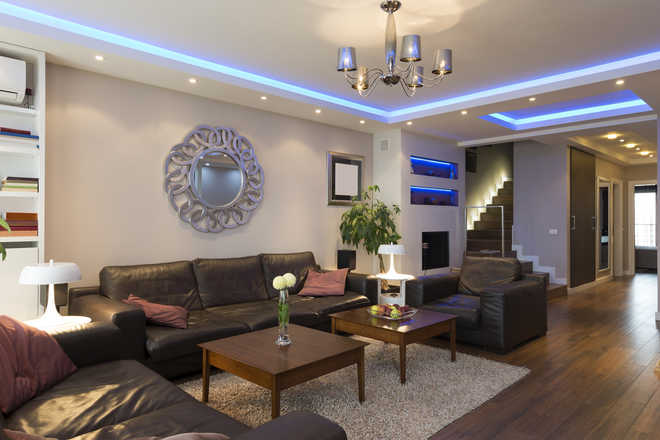
Jagvir Goyal
The world has come a long way as far as lighting choices are concerned. From candle lights to incandescent bulbs, from tube lights to CFLs and now, the LEDs have taken the world by the storm. Though LEDs have been on the scene for quite some time now, but these have really become house-friendly and cost competitive quite recently. Incandescent bulbs are fast disappearing from the scene and acquiring a nostalgic value while CFLs are now being replaced in view of the advantages of LEDs. A promising feature of LED bulbs is that these don’t use mercury and thus are environment friendly while use of mercury is an issue with the CFLs. Proper disposal of CFLs is an area of concern for which promotional schemes are often launched for deposit of used and damaged CFLs with the sellers and to get some discount.
In LEDs, there are no UV radiations also. On touch, LED bulbs are found cool while you can’t touch other bulbs after some time as these get very hot after prolonged use. Not that LEDs don’t produce heat but these are provided with a heat sink for thermal dissipation. Thus LEDs have all the good features of lowest energy consumption, long life, no UV radiation and no use of mercury. Let’s have a look at the LED scene:
The perfect fit
The LED bulb type lights now produced to fit into the same sockets that are already provided in the house for conventional bulbs and CFLs. Thus, there can be instant replacement of bulbs by LEDs and the house owner need not go for a change of sockets. The LED bulbs look very much like the conventional bulbs and CFLs. These two factors are a major attraction for the house owners.
LED bulbs produced now have both Pin type and threaded type bases and can be chosen as per the type of socket. The Pin base is known as B 22 base. The type of base is mentioned on the bulb pack and you can check it from the bulb pack instead of taking out the bulb from the pack. The thread type base is known as E14 or E27 base. E denotes Edison and such a threaded base is called Standard Edison Screw base. E14 base is slim base of 14 mm diameter while E27 base has 27 mm diameter.
Wattage
LED Glass bulbs have a wattage of 3W, 5W, 7W, 10W, 12W and 16 watts. These are good replacement of CFLs. LED rocket lamps are produced in 18 W, 25 W, 35 W and 45 Wattage. These can replace high power CFLs and HD lamps. The LED globe lamps are of 8 Watt only but act as good outdoor lamps.
Brightness
The lumen levels produced by a bulb indicate the brightness of the light a bulb produces. An incandescent lamp produces 10 to 15 lumens per watt while a CFL produces 50 to 70 lumens per watt. An LED produces 70-110 lumens per watt. More are the lumen levels, more is the brightness. So check the lumens that you need, not the wattage of the bulb. A 100 watt incandescent lamp can easily be replaced by a 3 watt LED to have same amount of brightness. Some LEDs give even 120 lumens per Watt.
The cost factor
No doubt, among the incandescent bulbs, CFLs and LED bulbs, LEDs are the costliest but the manufacturers are now cutting down their cost and keeping in view their long life and other properties, these look much better choice. If a 12 W B22 pin base LED of good brand costs about Rs 210, a 15 W CFL should cost around Rs 150 today. The cost gap is narrowing while life of LEDs is unimaginably long.
Life span
LED bulbs have life span in the range of 30,000 to 50,000 hours. Incandescent lamps have a life span of about 1200 hours. CFLs have a life span of 8,000 to 10,000 hours. Manufacturers provide 2 years' warranty for LEDs and CFLs. An LED is therefore equivalent to 25 incandescent bulbs or 4 CFLs and thus proves cheaper when energy efficiency and life span are taken into account.
LED tubelights normally have a life span of 50,000 hours. These are produced in lengths of 1 feet, 2 feet and 4 feet. Their normal diameter is 26 mm only and these look slim like fluorescent tubes. LED tube lights are produced both with and without extruded aluminium body support. These have a wattage as low as 16 Watts for standard 4 feet length but are also produced in 18 watt and 22 watt input power. LED tube lights have lumen levels of plus 100 lumens per watt and thus well illuminate an area at a small input power in watts. LED water proof tube lights are also produced in 20 W power. These have a diameter of 33 mm and are suitable for outdoor use.
— The writer is Engineer-in-Chief, Civil Engineering Department in a Punjab PSU
What is an LED?
LED is the short form of Light Emitting Diode. A diode emits light when it is activated by applying suitable voltage to its leads. LEDs have no glass or filament in them. Nor these contain any mercury. These have higher cost in comparison to CFLs but have very long life.



























